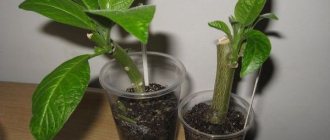Catharanthus is a small genus of shrubs and herbaceous plants belonging to the Kurtaceae family. Often grown as an annual, it overwinters in the ground only in the south. Originally it belonged to the genus Vinca and is very similar to it, which is why it is still found under the name Vinca rosea. In potted or container culture, catharanthus ampelous and erect are distinguished, differing only in the nature of shoot growth.
Catharanthus is not called the flawless flower for nothing
Features of ampelous catharanthus
Pink catharanthus (Catharanthus roseus) is a species that became the progenitor of all varieties and hybrids. This is an upright subshrub with shoots from 30 to 60 cm long. When they began to engage in crop breeding, special attention was paid to creating hanging varieties that can be grown not only on sunny windowsills, but also in flower pots and hanging baskets. Plants that are abundantly covered with flowers and with hanging vines look especially beautiful in vertical gardening and balcony boxes.
The branches of the ampelous catharanthus actually grow upward and then droop. Breeders try to make the shoots thin and flexible so that they begin to bend immediately after regrowth, and not at a height of 15-20 cm. Varieties have appeared with stems reaching 1-1.5 m.
general description
In appearance, this deciduous shrub resembles periwinkle, but it does not belong to this family. For a long time, specialists - botanists also thought so. But after careful research, the plant was separated into a separate catharanthus family. Lovers of the flower more often call it pink periwinkle or vinca. It is often called periwinkle because of the perennial's resemblance to the classic periwinkle. This genus has only eight species. But only one is grown in flower beds, namely rose catharanthus. Recently, the variety of catharanthus ampelous has become more widespread.
The homeland of the pink periwinkle is not precisely determined due to its wide distribution. It grows in the subtropics and tropics of Africa, Indonesia and many other parts of the planet. In warm areas, pink periwinkle is considered a perennial garden ornament, while in northern areas it is considered an annual or indoor plant.
This tropical flower is an evergreen subshrub, reaching a height of just over half a meter. Its stems are erect and strongly branched in the upper part. In ampelous forms, the stems are longer and droop. That’s why the wine is usually hung on the window. The stems have very bright flowers and, in combination with hanging green leaves, look quite impressive. Its leaves are sessile and arranged oppositely. The shape is oblong, lanceolate and has a smooth edge. The color of the leaves is bright, dark green. Their length is no more than seven centimeters.
The flowers of the plant are quite large, approximately 3 cm in diameter, and are similar to the flowers of phlox or balsam, but unlike phlox, they are not collected in inflorescences. It blooms from approximately the beginning of May to the end of November. Flowers have no smell. They come in pink, white or purple shades with a yellow or crimson center. The fruit is bileaf.
Catharanthus is poisonous, and all its parts are poisonous. Therefore, such a plant should not be grown in a room where there are animals or small children.
The best varieties of ampelous catharanthus
Whether intentionally or accidentally, the most popular ampelous catharanthus are combined into a series of varieties. What they have in common is the length of the lashes, the shape and size of the flower or leaves. The color of the corollas of different varieties varies within the group.
The popularity of ampelous catharanthus is due not only to the early appearance of buds and their number. The genus name translates as “pure, flawless flower.” The corollas of catharanthus are truly impeccable in shape, and the color, whether bright or pastel, is surprisingly rich.
Titanium
One of the most famous series of varieties. Titan has the largest flowers today among ampelous catharanthus - about 5 cm. The buds open earlier than other varieties by 2 weeks.
Shoots up to 75 cm long first grow upward, then bend in different directions and hang. The result is a neat ampelous catharanthus about 15 cm high, 25-30 cm in diameter. If the stems are constantly cut or pinched, they will not hang, but bend. By providing support, you can get a spreading bush up to 30 cm high.
The leaves, characteristic of catharanthus, are dark green, small, oval. The varieties are resistant to temperature fluctuations and can tolerate short-term drying out of the soil.
Important! Catharanthus ampelous Titan is a hybrid. You can propagate it yourself only vegetatively. Plants that do not inherit the characteristics of the variety will grow from planting material collected with one’s own hands.
It is easier to buy mixed seeds on sale than any specific flower from the Titan series. If you're lucky, you can find:
Punch – rich magenta color;
Titan Punch is distinguished by evenly colored flowers
Rose Helow is a bright pink flower with a white center;
Titan Rose Helow is a variety distinguished by its particularly rich color of flowers
Burgundy - the name says about the color, the middle is dark burgundy;
Titan Burgundy looks good in a hanging basket and as a ground cover
Lilac - violet petals with a darker center;
Catharanthus Titan Lilac flowers are especially large
IcePink is a pink flower with a center several shades darker.
Read more Propagation of catharanthus by cuttings at home
A delicate pink catharanthus flower Titan Ice Pink is decorated with a spot of a darker shade in the center
Bark Cascade
Another variety series of ampelous catharanthus. The flowers sometimes reach a diameter of 5 cm, but are usually more modest in size and cannot compete with the Titan group in this regard. But the shoots of the Cascade Bark are thin, falling at a height of about 10 cm. The length of the stems in some varieties of the series can reach 1.5 m without pruning. Most have a dot or pea of contrasting color in the center of the flower.
Important! This is the only series resistant to late blight.
Popular varieties of hanging catharanthus Bark Cascade:
Lilac shoots up to 90 cm long, flowers are bright, pink-purple with a red center, up to 5 cm in diameter;
Bark Cascade Lilac blooms profusely from spring to late autumn
Lavender – lavender corolla, white petal bases, stems up to 60 cm;
Catharanthus flowers Cora Cascade Lavender will not go unnoticed
Strawberry is an ampelous catharanthus with deep pink flowers with a large red spot in the center;
Cascade Strawberry bark is considered one of the most beautiful catharanthus varieties
Cherry – bright red with a white center;
Bark Cascade Cherry red with white center
Magenta - the color of the flower corresponds to the name, the variety is similar to Titan Punch, even the dark pea in the middle is not too noticeable, only the flower is much smaller - 3-4 cm;
Catharanthus Cora Cascade Magenta is similar to the Titan Punch variety, but its flower is noticeably smaller
Apricot is a soft apricot ampelous catharanthus with a red center.
Color of flowers of the Cora Cascade Apricot apricot variety
Mediterranean
The Mediterranean variety series is one of the most famous. The name of these catharanthus would be correctly translated into Russian as Mediterranean, but the transcription Mediterranean has taken root. Compared to other series, the shoots are not too long - 50-75 cm. The diameter of the flower is slightly smaller than that of Titan, but larger than the Cascade Bark - 4-5 cm.
Comment! In the Mediterranean series, the entrance to the tube is almost always clearly visible, looking like a yellow dot. The line is famous for the fact that only it contains pure red flowers.
Popular varieties of hanging catharanthus from the Mediterranean series:
White – bush height 10-15 cm, shoots up to 75 cm, flowers completely white;
Catharanthus Mediterranean White flowers are white
Peach is an almost white flower, with a barely noticeable cream tint, with a crimson ring at the base of the petals;
The coloring of the Mediterranean Peach is very delicate
Rose Halo - ampelous catharanthus with a bright pink corolla and a white spot in the center;
Mediterranean Rose Halo pink, with a large white spot in the center
Red - a red flower, at the entrance to the pharynx there is a thin short white line along the edge of the petal.
Such a pure red color as that of Catharanthus Mediterranean Red is rare
Use in the garden, on the balcony
Pink catharanthus is an extremely attractive, long-flowering exotic plant that will add a lot of charm to garden beds and become an original decoration for balconies and terraces. It blooms in summer and even in hot weather shines with freshness, captivating with its numerous flowers and bright green leaves. In hot climates, plants are often used to create colorful carpets. They bloom for a long time, although in the fall, in cold weather, the flowers become smaller and smaller. Only frost kills them.
If there are sunny, fairly dry places in the garden, you can plant catharanthus as a ground cover plant.
Catharanthus is a beautiful plant used in gardens, urban green spaces, and on balconies. Its greatest advantages include: resistance to drought and heat, low requirements, ease of care (including self-cleaning of faded flowers) and high decorative qualities.
Growing ampelous catharanthus at home
The ampelous catharanthus propagates easily. If compliance with varietal characteristics is important, you can take cuttings from an adult bush. Divided into parts, it does not take root well.
Seeds need to be purchased from reliable producers. Those collected with your own hands will most likely grow into ampelous catharanthus, the flowers of which are not similar to the original variety. But you can decorate a flowerbed with them and throw them away in the fall.
Seeds
The seeds of the ampelous catharanthus are sown from the end of February to the beginning of March in a light substrate, planted to a depth of 1.5 cm. When you do not need too many flowers, it is better to provide them with separate containers right away, this way the formation of buds will begin faster.
Cups or trays are placed in a warm place, covered with glass or transparent film. Ventilate and check humidity daily. When the shoots appear, they are placed on a bright windowsill.
If picking is needed, wait until the catharanthus produces 3-4 true leaves. Several plants are planted in each container.
Important! The most abundant flowering of ampelous catharanthus can be achieved only by seed propagation in the first year of life.
Cuttings
From one bush of varietal ampelous catharanthus you can get many new plants. Cuttings are taken during spring pruning. The length should not be less than 10 cm. You can root them:
- In water. Cuttings need to be placed 1-3 pieces per container, otherwise there is a high probability of stem rotting. It is useful to add an activated carbon tablet to each glass.
- You can root ampelous catharanthus in peat, sand, perlite or vermiculite.
Read more How and when to sow catharanthus seeds for seedlings
The cuttings are kept in a warm place with high humidity. The lighting should be good, but not too bright. You can place the containers on a table next to the window, but not on the windowsill.
After a few weeks, the cuttings planted in the substrate will produce new leaves, and those standing in the water will take root. They are planted in separate containers of 2-5 pieces or in flower beds.
Dividing the bush
It is recommended to divide only the old bush. In the spring, when transplanting, remove the earthen lump from the pot and carefully shake off the substrate. Then, by hand or using a sharp sterile knife, they are divided into several parts.
Important! Catharanthus does not like to have its roots disturbed. This method is the most unreliable. If the gardener sees that the plant has not recovered after division, the cuttings must be rooted urgently. In this case, it is mandatory to use a root formation stimulator.
Trimming
In spring, pink periwinkle shoots are cut back by about a third. This procedure allows not only to rejuvenate the plant, but also to create a compact bush. If the plant has become very elongated, it can be pruned again in the summer. Cut stems bloom in about a month.
Since the periwinkle bush grows indoors, it should not be grown for more than three years. After three years, it is completely renewed using cuttings. Young plants look more attractive than old ones. Catharanthus growing in a street flower garden also needs pruning. After all, the pruning process speeds up branching, and the bushiness of the vine increases the number of flowers.
As for the ampelous type of catharanthus, it is rarely pruned. You only need to cut off those branches that spoil the appearance, because the more they hang, the more beautiful the plant.
Gardeners who developed new varieties selected hybrids with maximum branching. It should be remembered that this plant is poisonous, so you need to wear gloves when cutting it.
Rules for caring for ampelous catharanthus
Caring for the plant is not difficult. But if you do not create the proper conditions for the flower, it will become sick or bloom poorly.
Comment! After 3-4 years of cultivation, ampelous catharanthus hopelessly loses its attractiveness. It becomes difficult to maintain even with trimmings. It is recommended to re-root the apical cuttings in the spring and plant the old flower outside or throw it away.
Catharanthus need to be renewed every 3-4 years
Temperature
The best temperature for ampelous catharanthus is moderate, from 18 to 21 °C. It is not clear where the information came from that he loves the heat at 27-28 °C. The flower feels good at 25 ° C; if the temperature rises, you need to increase the humidity and provide an influx of fresh air.
Important! Draft is contraindicated for ampelous catharanthus. When placing in hanging baskets outdoors, this should be taken into account.
In order for the flower to overwinter well, it must be placed away from heating devices and kept cool. The optimal temperature is 15 °C.
Watering
Catharanthus, including ampelous, is a moisture-loving plant. In summer it needs to be watered often, but it should not be made into a swamp. To avoid stagnation of water and rotting of roots, the pot must have drainage holes.
In winter, watering is reduced. In between moistenings, the top layer of the substrate should dry to the depth of the phalanx of the index finger.
Feeding
In spring and summer, ampelous catharanthus is fed twice a month. You only need to use fertilizers for ornamental flowers - the plant blooms profusely and needs a special “diet”. Even if you give universal fertilizing, the formation of buds will slow down.
Read more How and when to sow catharanthus seeds for seedlings
In the fall, ampelous catharanthus is fertilized less intensively, and from mid-October it is stopped altogether.
Lighting
In summer, hanging catharanthus should not stand on southern windows without protection from the sun. The plant is light-loving, but it is better to place it on the southeast or southwest side.
Comment! In winter and on northern windows, additional lighting will be required.
On the street, you need to protect the ampelous catharanthus from the midday sun.
Soil and pot
The soil for catharanthus needs light, permeable, with a neutral or slightly acidic reaction. It’s better not to do it yourself, but to buy a ready-made substrate for violets or geraniums.
You should take a 2-4 liter pot so that the bush is lush; 3-5 plants are planted in one container, and they need space. If there are no holes below for water drainage, make them yourself. The drainage layer should occupy at least 20% of the volume of the pot.
Important! Catharanthus ampelous should be transferred annually in the spring to a large container and fresh substrate.
Reproduction
Seeds
Before sowing, seeds are treated with a weak solution of manganese: approximately 2 g per liter of water. Before disinfection, the seeds must be wrapped in gauze and immersed in a manganese solution for 30 minutes.
For the ampelous catharanthus plant, growing from seeds does not require special knowledge in breeding. Seeds are usually sown at the end of February or early spring. This is done in special boxes for seedlings at a depth of no more than 2 cm, in moist soil. After this, the boxes are covered with an opaque black film, for the reason that the seeds germinate in the dark.
New shoots sprout quickly, within about a week, and their appearance is very rapid if the air temperature in the room is not lower than 22C. After small plants germinate, they need to be taken out to a bright room and the temperature lowered by 2-3 degrees. A couple of weeks after this, fertilizers containing a little phosphorus in their composition are added to the boxes. When small seedlings produce 4 leaves, they need to be picked. If in the future the bushes will be grown in pots, it is better to plant them 2-3 in one. In this way, greater pomp and elegance will be achieved.
Diseases and pests
In open ground, catharanthus gets sick and is often attacked by pests. Even late blight may appear on it. During prolonged cold spells or rainy weather, there is a danger of the development of various rots. Therefore, if a florist is going to dig up and bring into the house a bush growing in a flower bed, it must first be carefully examined.
This is how late blight begins on catharanthus
In potted culture, ampelous catharanthus often suffers due to maintenance errors:
- from excessively intense lighting, the leaves turn yellow and become smaller;
- at low humidity their tips dry out;
- ampelous catharanthus forms few buds when kept in cold, dark conditions and lack of nutrients;
- the flower may get sick and disappear due to the container being too small;
- Excessive watering, lack of drainage and lower holes in the pot will lead to rotting of the roots and stems.
Among the pests, catharanthus ampelous is affected by whitefly, mealybug, and aphid.
Insecticides will help get rid of insects; diseases are treated with fungicides.
Priming
Catharanthus needs light soil, which also has a large supply of nutrients. The soil can be purchased at a flower shop, or you can make it yourself by combining different types of soil with sand and peat in equal quantities.











